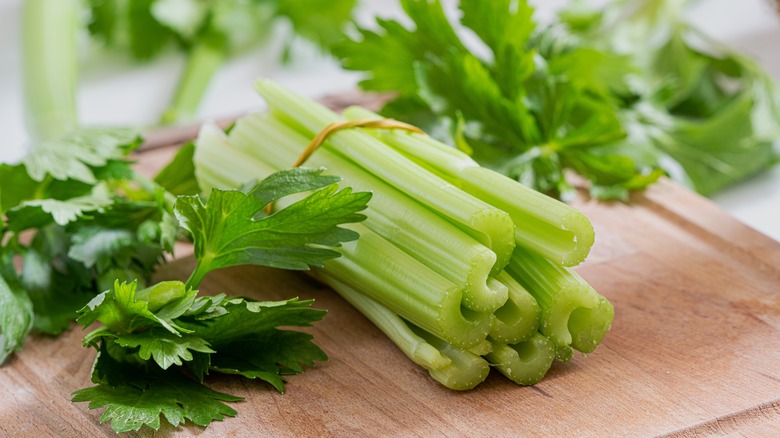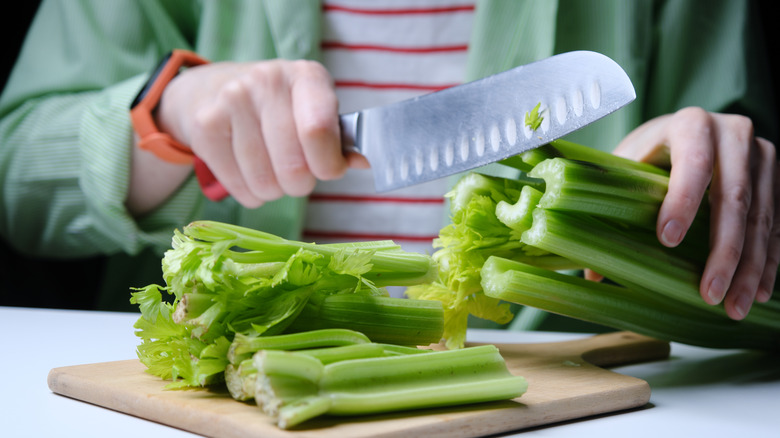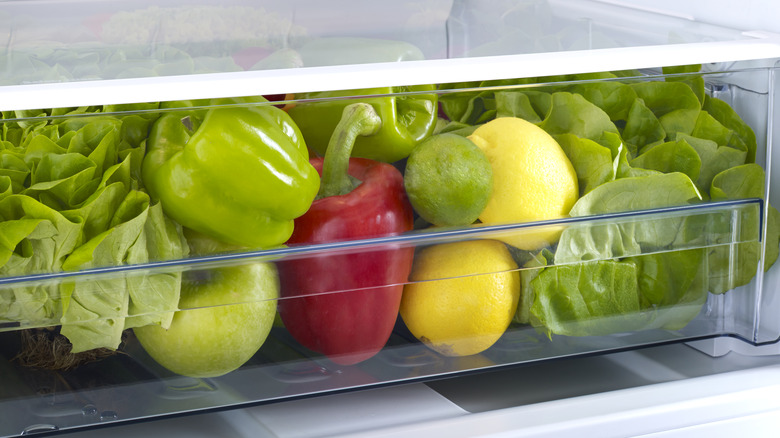Salt-Cured Celery Is The Best Way To Get A Delicious Crunch Every Time
From a Bloody Mary garnish to being filled with peanut butter, the simple celery stalk has a myriad of uses. While that member of the parsley family can be eaten root to tip, there is one situation that no one finds appetizing, the dreaded flaccid celery. The simple solution to keeping that satisfying crunch is to master salt-cured celery.
As shared by Food and Wine, Chef Kristen York of Seaworthy in New Orleans stores prepped celery in a salt cure. The salt solution, or brine, allows the celery to pickle, which helps to give the vegetable a satisfying crunch. For her salt cure, York uses one part kosher salt to 10 parts water. While that particular shortcut, simple ratio seems straightforward, the resulting product has a bright note that can help round out flavors in various dishes. In that chef's serving suggestion, it was the textural component in her lobster roll.
While this method has value, home cooks should use this quick pickle with care. Celery is almost 90% water. Overly salted water will cause the stalks to get limp and soggy. Just like an ingredient in any recipe, salt balance is key. While pasta water might be salted to the brininess of the sea, salt-cured celery has a little less salinity in that water bath.
What's the best way to store celery?
From an ingredient in a mirepoix to a crudite staple, celery is a classic vegetable with a multitude of uses. While it is relatively easy to prep, keeping that vegetable fresh might not be quite as simple. After all, no one wants a soggy stalk.
According to HarvestToTable.com, celery prefers to be stored in a cold, moist environment. Even though a refrigerator seems cool, the vegetable prefers a chiller temperature, closer to freezing. In addition, wrapping celery in a damp cloth or paper towel can help to retain moisture levels. The crisper section can be preferred to the main shelf.
In addition, it is best to prep that celery after purchase; specifically immediately ditching the plastic bag packaging. Celery emits ethylene gas, which can cause the vegetable to ripe quickly when it cannot escape the plastic packaging. Still, people might prefer to have those stalks contained in some manner. Wrapping the pieces in aluminum foil is a popular choice. Unlike a tight seal for cooking, this foil packet needs to be slightly open to allow the ethylene to escape.
Lastly, it might be best to cut off the celery leaves. Stalks without their leaves tend to last longer. But, do not just throw out the leafy bits. They can be used as a garnish or even in a salad.
The simple way to save soggy vegetables
While proper vegetable storage and handling is important to avoid food waste, some cooks have found hacks and tricks to help revitalize soggy vegetables on the brink. Putting aside the idea of throwing the food into a stock, puree, or other recipe idea that hides the texture, the easiest way to revive the stalks is with water.
Given that vegetables are primarily water, submerging them into some ice water can infuse some perkiness to their soggy state. Like any grown product, once the water source is removed, the cells lose their hydration and shrink. As the icy water returns balance to the vegetables, the appearance will become sturdier, and more appetizing.
While this food hack can help keep some vegetables from the compost pile, it does not work with food that has turned. For example, signs of mold, a slimy quality, or other visual issues should mark those veggies as destined for the trash bin. Water might not necessarily be the fountain of youth, but it can be the hydrating option to extend the produce's shelf life after sitting a little too long in the crisper drawer.


